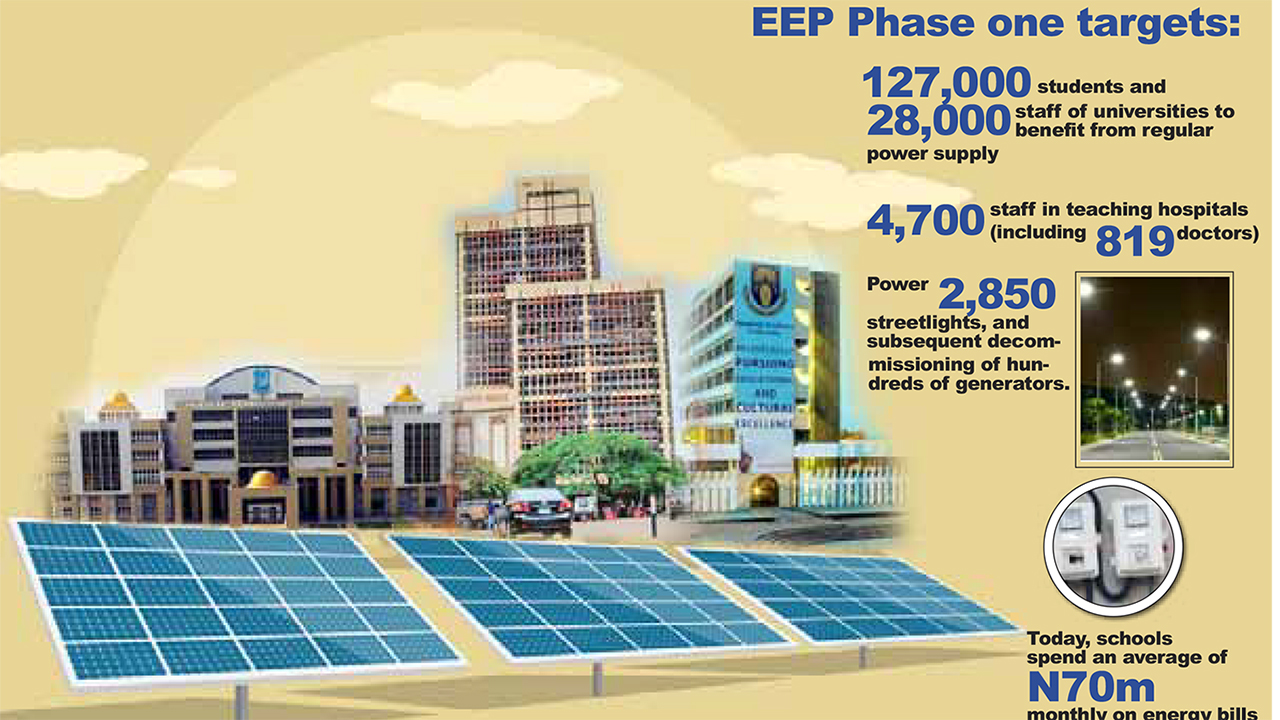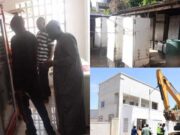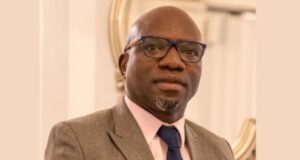
Six years after the $105 million-worth of special intervention to electrify public varsities and some tertiary hospitals nationwide, several beneficiaries listed in the phase one of the initiative are yet to get the power supply.
Besides the trio of Alex Ekwueme Federal University, Ndufu-Alike Ikwo (AE-FUNAI), Ebonyi State, Usmanu Danfodiyo University, Sokoto (UDUS) and Federal University of Agriculture, Makurdi (UAM) that confirmed enjoying constant supply from the power stations, the same project is in various stages of abandonment in other six varsities and one hospital.
It will be recalled that the Federal Government launched the Energising Education Programme (EEP) to provide sustainable and clean power supply to public universities and seven teaching hospitals across Nigeria.
Planned to be developed in phases, the first leg was expected to deliver 28.5MW to nine federal universities and one teaching hospital, using solar hybrid and gas-fired captive power plants.
Phase one of the EEP, being implemented by the Rural Electrification Agency (REA), aimed to benefit 127,000 students and 28,000 staff of universities, 4,700 staff in teaching hospitals (including 819 doctors), power 2,850 streetlights, and subsequent decommissioning of hundreds of generators.
Besides Alex Ekwueme, UDUS and UAM, other beneficiaries are: Bayero University, Kano (BUK); Federal University of Petroleum Resources (FUPRE), Effurun, Delta State; Obafemi Awolowo University (OAU) Ile-Ife, and its Teaching Hospital.
Others are University of Lagos (UNILAG); Nnamdi Azikiwe University Anambra State (UNIZIK); Federal University of Agriculture, Makurdi (UAM) and Abubakar Tafawa Balewa University (ATBU) Gubi Campus, Bauchi.
Indeed, energy poverty remains a major problem, not just in the tertiary institutions, but across the entire facet of Nigerian society.
It however poses even more challenges in the universities where it has become a barrier to effective research, student learning and general smooth running of the institutions.
A report by the World Bank group, titled: ‘The impact of school infrastructure on learning: A synthesis of the evidence’, showed that the absence of a consistent electricity supply poses challenges to students, impacting productivity and hindering academic success.
Part of the EEP project was the provision of an independent power plant, upgrading existing distribution infrastructure, street lighting to improve security within the campuses, as well as the development of a world-class training centre on renewable energy for each university.
The project received backing from the World Bank, allocating $105 million for programme implementation. The funding encompassed engineering, procurement and construction for power plants, installation of streetlights to enhance campus security, rehabilitation of existing distribution infrastructure, one-year operations and maintenance for the power plant, and the establishment of state-of-the-art workshops and training centres.
However, checks by The Guardian showed that while the EEP is running fully at UAM, AE-FUNAI and UDUS, the project has not appreciably progressed in other universities.
Findings showed that the project is yet to commence at both the University of Lagos and OAU. At the site of the EEP project at UNILAG, there was no power plant, but only a signpost to show the project site.
Vice Chancellor of UNILAG, Prof. Folasade Ogunsola, said while the contract for the project was awarded in December 2017, nothing has happened since the land was acquired.
Ogunsola said the project site was swampy, but since reclamation was done, nothing has happened. At OAU, an official confirmed that materials were brought to the institution for the commencement of the project but lamented that they are wasting away as the contractor has abandoned the site.
The official expressed concern over the huge electricity bills being paid by the institution, saying when the school was named as a beneficiary of the EEP initiative, they had high hopes, but six years down the line, nothing has happened.
At BUK, it was learnt that the solar hybrid power plant, inaugurated in 2019, stopped working three years ago. It was learnt that the solar plant only worked for a few months, while the school has returned to running generators.
The Director, Public Affairs of the institution, Lamara Garba, while providing details of the present state of the solar plant, identified rainfall as the cause of damage, saying the school does not have such an amount of money to fix it.
“The solar plant served the school within the period it was fixed in 2019 and some part of 2020. We discovered that it is the converter that got damaged and will cost a fortune to repair.
“The company is giving several reasons why it can’t come to Africa for now. They were able to detect the problem from their base in Germany but have not been able to fix it.
“Information we got was that it would cost over N300 million to fix the problem, which the school cannot afford, not with the volume of issues on ground,” Garba stated.
Although the project is said to be ongoing at UNIZIK and FUPRE, it is not functioning well as the schools have returned to using generators. A senior lecturer at FUPRE confided in The Guardian that the school still relies on generators. The official lamented that when they run out of diesel, the entire school is left in darkness.
The situation is also the same at UNIZIK, as the school relies on generators to function. In the absence of EEP’s power supply, the alternatives of paying bills for public supply and cost of fuel for backup have been burdensome on the universities’ lean resources.
Findings have shown that the cost of fueling and maintenance of power generating plants by the universities take a chunk of their budgets because of epileptic power supply and the imperatives of running the schools on diesel.
Lately, the Nigerian Electricity Regulatory Commission (NERC) had increased electricity tariff from N30.23 per kilowatt per hour (kwh) to N62.33 per kwh for customers in band A, B and C, who enjoy at least 12 hours and above of electricity supply daily.
Most of the institutions are not having it easy paying electricity bills because of high tariffs. For instance, UNILAG pays an average of N80 million monthly, same also for University of Ibadan (UI), University of Ilorin pays about N45 million, University of Jos hovers between N25 and N27 million monthly, OAU pays between N70 and N80m, while BUK pays N75m monthly.
But the narrative is different in the other three universities that are already on the cost-saving initiative. For instance, the UAM said the institution saves about N13 million monthly.
At AE-FUNAI, the power plant is said to be functioning properly, as an official confirmed that the university has three sources of power: a diesel generator, which serves as a backup during an emergency; the solar panels with 3,500 modules, and batteries.
“We serve the whole university community for 24 hours with solar power. If we have a long overcast, we will quickly switch back to the diesel generator. We have only had glitches twice since commissioning, which didn’t last for more than an hour. So, the generators are redundant,” he said.
“We also have a battery bank room. The university’s demand is less than one megawatts. They are just taking about 30 to 40 per cent of the capacity,” the official stated.
At Federal University of Agriculture, Makurdi, Benue State, students and teaching staff now have access to electricity supply from the institution’s 8.25 MW solar hybrid power plant.
The situation is the same at UDUS, as the solar hybrid power plant powers the main campus, the main library and over 8km of solar-powered streetlights, illuminating the campus.
A 200-level Chemistry student at Alex Ekwueme Federal University, Nonye Obunde, called solar a “gamer changer.” To further enhance the academic environment, she urged the school to extend solar installations to all departments, addressing areas without adequate streetlight coverage.
A lecturer at UDUS, Dr Ahmad Rabiu, emphasised the positive impact on both students’ reading habits and campus safety. He suggested reallocating two additional hours of daytime solar power to the evening, highlighting the dual benefits of increased security and improved study conditions.
Reflecting on the university’s cost reduction by utilising solar energy, he urged other institutions to follow suit to reduce the huge amount spent on electricity and diesel.
While acknowledging financial challenges, Rabiu commended non-governmental organisations and individuals that support solar initiatives in some universities.
Advocating for government support, he acknowledged the difficulties in obtaining solar power, but expressed hope that lobbying efforts by universities could make a difference.
Stressing the importance of maintenance fees for sustainability, Rabiu recalled many instances of lecture interruptions and laboratory challenges due to electricity shortages.
With a nod to the growing importance of solar power amid unreliable power services, he predicted a future when solar prevails, especially in the institutions.


















































